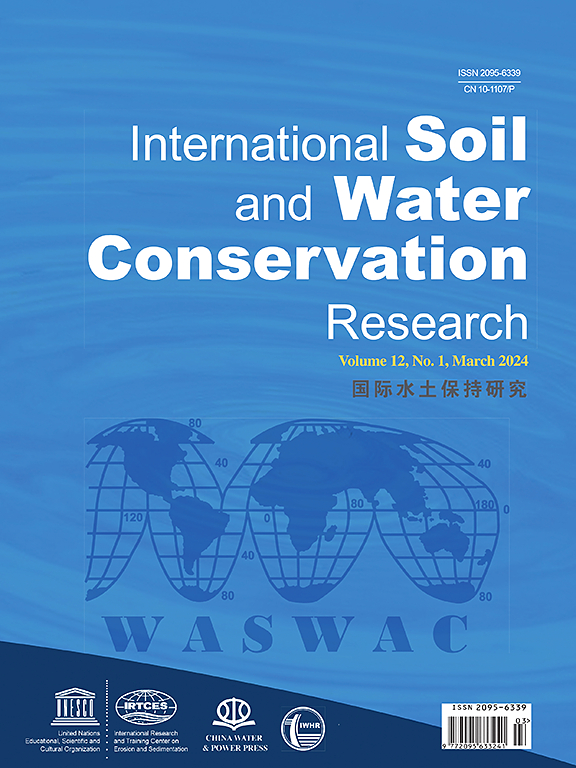HOTSED: A new integrated model for assessing potential hotspots of sediment sources and related sediment dynamics at watershed scale
IF 7.3
1区 农林科学
Q1 ENVIRONMENTAL SCIENCES
International Soil and Water Conservation Research
Pub Date : 2024-06-17
DOI:10.1016/j.iswcr.2024.06.002
引用次数: 0
Abstract
In this paper we introduce HOTSED, a novel, innovative GIS-based model designed for assessing potential hotspots of sediment dynamics at watershed scale. HOTSED integrates geomorphic spatial information with both structural and functional properties of connectivity. HOTSED provides a single and intuitive output that depicts the location of sediment source hotspots. Moreover, it enables the identification of “relative hazard” classes for sediment production and related effects. The general methodological framework is based on the initial elaboration of an Inventory Map (IM) of sediment-related landforms and processes, along with the implementation of a corresponding database. Subsequently, we used data stored in the IM to estimate the geomorphic Potential of Sediment Sources (PSS) through a relative scoring system. Furthermore, we computed Structural Sediment Connectivity (STC) and the Potential for Sediment Transport (PST) by combining terrain and hydrological parameters, vegetation roughness, and rainfall erosivity. Afterwards, PSS, STC, and PST components are integrated through a raster-based calculation method yielding the HOTSED model. We tested the HOTSED procedure in the upper Val d’Arda-Mignano watershed, which is a representative geomorphologically highly active Mediterranean area of the Northern Apennines (Italy). Through photointerpretation, terrain analysis, and fieldwork, we mapped sediment-related geomorphic features for a total of 4640 ha including: badlands and gullies (0.26%), rill-interrill erosion (15.03%), fluvial erosion (0.03%), landslides (70.06%), litho-structural erosional systems (0.87%), slope deposits (12.56%), and alluvial deposits (1.19%). HOTSED revealed hotspots with a very high hazard potential located near main channels or upstream of the reservoir. These areas are often linked with active landslides highly connected to the drainage system and frequently associated with other processes like bank erosion or surficial soil erosion. The model also highlighted linear hotspots corresponding to drainages flowing alongside or intersecting complex geomorphic systems such as landslides. Furthermore, HOTSED identified areas where sediments are stored in depositional landforms, exhibiting a low hazard potential, considering both low geomorphic potential and sediment connectivity. Our conceptual model is generally applicable but proves to be particularly effective in areas characterized by complex and polygenetic geomorphic systems, such as the Northern Apennines. HOTSED offers a valuable tool for watershed authorities to support sustainable watershed and reservoir management.

HOTSED:流域尺度泥沙源潜在热点及相关泥沙动力学综合评估新模型
在本文中,我们介绍了一种新颖的、创新的基于gis的模型HOTSED,用于评估流域尺度上泥沙动力学的潜在热点。HOTSED将地貌空间信息与连通性的结构和功能特性相结合。HOTSED提供了一个单一的和直观的输出,描绘沉积物源热点的位置。此外,它还能确定泥沙产生和有关影响的“相对危险”等级。一般方法框架的基础是初步编制与沉积物有关的地貌和过程的清单图,并执行相应的数据库。随后,我们利用存储在IM中的数据,通过一个相对评分系统来估计沉积物源的地貌潜力。此外,我们结合地形和水文参数、植被粗糙度和降雨侵蚀力,计算了结构泥沙连通性(STC)和输沙潜力(PST)。然后,通过基于栅格的计算方法将PSS、STC和PST分量整合在一起,得到HOTSED模型。我们在Val d 'Arda-Mignano流域上游测试了HOTSED程序,该流域是意大利北部亚平宁山脉具有代表性的地貌高度活跃的地中海地区。通过光解释、地形分析和实地调查,我们绘制了4640公顷与沉积物相关的地貌特征,包括:荒地和沟壑(0.26%)、沟沟间侵蚀(15.03%)、河流侵蚀(0.03%)、滑坡(70.06%)、岩石-构造侵蚀系统(0.87%)、斜坡沉积(12.56%)和冲积沉积(1.19%)。HOTSED发现,位于主河道附近或水库上游的热点地区具有极高的潜在危险。这些地区通常与与排水系统高度相关的活跃滑坡有关,并经常与其他过程有关,如河岸侵蚀或表层土壤侵蚀。该模型还强调了线性热点,对应于沿复杂地貌系统(如滑坡)流动或相交的排水。此外,HOTSED还确定了沉积物储存在沉积地貌中的区域,考虑到低地貌电位和沉积物连通性,这些区域具有低危害潜力。我们的概念模型一般适用,但在以复杂和多成因地貌系统为特征的地区,如亚平宁山脉北部,被证明特别有效。HOTSED为流域当局提供了一个宝贵的工具,以支持可持续的流域和水库管理。
本文章由计算机程序翻译,如有差异,请以英文原文为准。
求助全文
约1分钟内获得全文
求助全文
来源期刊

International Soil and Water Conservation Research
Agricultural and Biological Sciences-Agronomy and Crop Science
CiteScore
12.00
自引率
3.10%
发文量
171
审稿时长
49 days
期刊介绍:
The International Soil and Water Conservation Research (ISWCR), the official journal of World Association of Soil and Water Conservation (WASWAC) http://www.waswac.org, is a multidisciplinary journal of soil and water conservation research, practice, policy, and perspectives. It aims to disseminate new knowledge and promote the practice of soil and water conservation.
The scope of International Soil and Water Conservation Research includes research, strategies, and technologies for prediction, prevention, and protection of soil and water resources. It deals with identification, characterization, and modeling; dynamic monitoring and evaluation; assessment and management of conservation practice and creation and implementation of quality standards.
Examples of appropriate topical areas include (but are not limited to):
• Conservation models, tools, and technologies
• Conservation agricultural
• Soil health resources, indicators, assessment, and management
• Land degradation
• Sustainable development
• Soil erosion and its control
• Soil erosion processes
• Water resources assessment and management
• Watershed management
• Soil erosion models
• Literature review on topics related soil and water conservation research
 求助内容:
求助内容: 应助结果提醒方式:
应助结果提醒方式:


